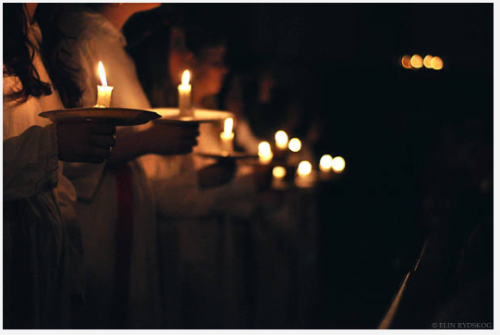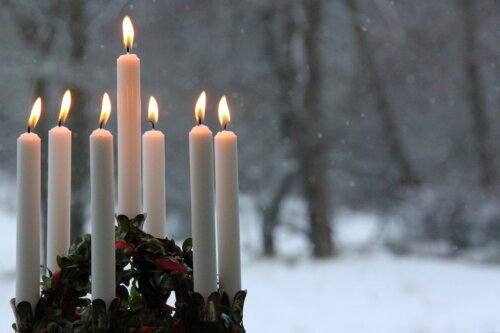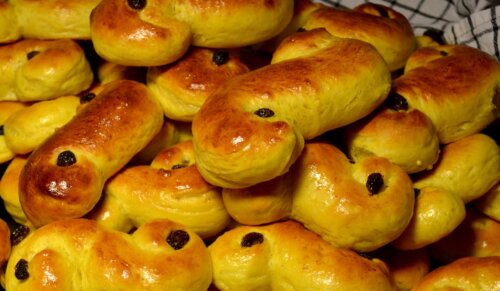December 10, 2023
Embracing light in darkness – Saint Lucia celebration
Welcome from snowy Linköping! 😀
In the heart of winter, when the days grow shorter and the nights longer, Sweden comes alive with a celebration known as Saint Lucia’s Day. The Lucia tradition is as inherent in Swedish culture as midsummer and crayfish celebrations. Saint Lucia’s Day is celebrated annually on the December 13th. This tradition, rooted in both religious and secular environments, is a sorrowful reflection of Sweden’s deep connection to light (or rather the lack of it 😀 ) during the winter months.
What are the historical origins of it?

The roots of the Saint Lucia tradition in Sweden are intertwined with both Christian and pagan influences. It can be tracked as far back as the IV century! The name Lucia is derived from the Latin word “lux,” meaning light, symbolizing the Christian belief in the light of Christ. According to legend, Saint Lucia who was a young Christian martyr from Syracuse, Italy, used to bring food and aid to Christians hiding in the Roman catacombs. To light her way she was wearing a wreath of candles on her head. According to the Julian calendar, December 13th coincides with the winter solstice meaning it is the shortest day of a year. Scandinavians considered this long night to be dangerous and spooky. Therefore, they stayed awake and ate food. Despite its long history, the first historical records of Lucia Day are only from the XVIII century.
How is it celebrated?
Central to the Saint Lucia celebration is the Lucia procession, where a young woman, chosen to portray Lucia, leads a group of girls dressed in white robes. Other participants can be added as well such as star boys, gingerbread men or Christmas elves. Lucia’s iconic element is a crown of candles, symbolizing the light surrounding her and the triumph of light over darkness. This metaphor resonates deeply in the Swedish consciousness during these loooong dark winters as it brings the promise of spring. Saint Lucia also has a red sash representing her martyrdom. The accompanying girls carry candles, and some may hold symbols like the star, gingerbread cookies, or saffron buns.

These processions are actually organised across Sweden involving schools, churches, workplaces and public spaces. Choirs, often comprised of children and adults, sing traditional Lucia songs, filling the air with melodies that have been passed down through generations. Traditionally, Lucia used to appear before dawn, but now, for practical reasons, the events are held at dusk.
What’s special for fika on that day?
As you may already know, Swedes love their fika. So, of course, Saint Lucia cannot be an exception and lack thereof.

Additionally to the warm flames of the crown piercing through the darkness, Lucia also offers treats. No Saint Lucia celebration is complete without the saffron buns (lussekatter) and gingerbread cookies (pepparkakor). Saffron buns are pastries shaped like an “S” or a curled-up cat, signifying the curled tail. These treats are enjoyed during the entire Christmas season but hold a special place on Saint Lucia’s Day. Various cultural and historical layers are intertwined with each other regarding the origin of these delicious saffron buns. One of them says that its bright yellow colour (coming from saffron) was supposed to scare the devil away during this long night as primarily, it was associated with the winter solstice. Gingerbread cookies, often shaped into hearts, stars, and goats, are another beloved tradition, both in decoration and consumption. With these sweet delicacies, you can sip on cute, little cups of glögg. It’s like a mulled wine served with almonds and raisins.

The Saint Lucia celebration is deeply ingrained in Swedish society, promoting a sense of community. It fosters the spirit of hope and light at the time of winter’s darkness. As candles flicker and choirs sing, Swedes collectively embrace the warmth and joy that this tradition brings and allows them to enjoy a little break with tasty sweets. The Saint Lucia celebration serves not only as a cultural tradition but also as a reminder that, even in the coldest and darkest times, the light of tradition can illuminate our hearts and homes.
I personally find this tradition beautiful. How about you? 🙂
/Aleksandra, Experimental and Medical Biosciences
________________________________________________________________________________________________
Why don’t continue the conversation with us?
Start with checking out:
Our programmes, the application process, webinars, and our Instagram and Facebook account.
Still left wanting more?Book an appointment with our recruitment coordinator at international@student.liu.se.




